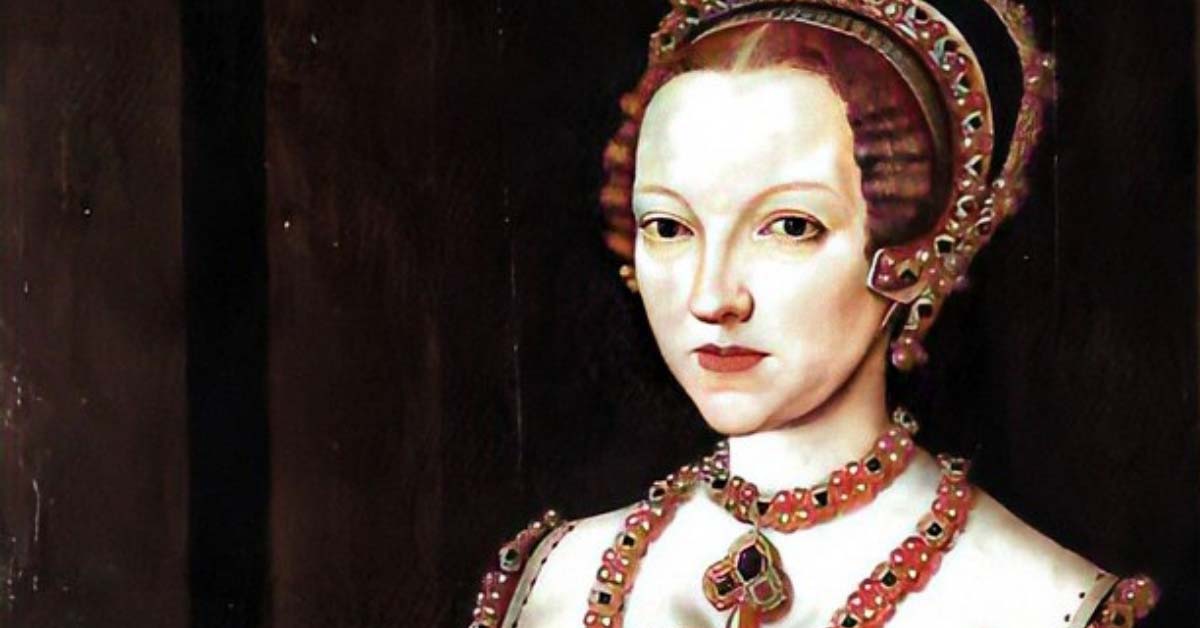It’s a scene straight from a Gothic novel:
A woman runs through a castle in the middle of the night. Her mercurial husband has turned on her.
Her next move will decide whether she lives…
…or dies.
The woman bursts into the bedroom, her heavy skirts folding in endless layers of silk as she sinks to her feet. Her husband greets her strangely.
He abruptly turns the conversation to religion. He looks over his shoulder and asks a seemingly nonchalant question: Can she clarify her opinion on the subject?
The woman recognizes the trap.
She responds with perfect poise: “I refer my judgment in this, and in all other cases, to your majesty’s wisdom, as my only anchor, supreme head and governor.”
Her husband presses her again, but she sticks firmly to the script, dodging his well-aimed arrows once more. Finally with a sigh, he declares, “Perfect friends we are now again.”
Sounds too dramatic to be true?
Sometimes the truth is more exhilarating than fiction.
Katherine Parr has just saved herself from being yet another of King Henry VIII’s headless wives.
The details of this dramatic episode come from John Foxe’s Actes and Monuments, first published in 1559. A martyrologist, Foxe intended to venerate early champions of English Protestantism and place them on the same level as Catholic saints.
We have to take his intensity of the scene with a grain of salt, but the broader historical record collaborates the heart of the story: Katherine Parr outwitted a broad political conspiracy calling for her execution by going straight to Henry VIII.
And she came out on top.
A Queen by Nature and Virtue
How is it that this dynamic woman is the most overlooked character in the Tudor story?
Even if she makes an appearance in a juicy historical miniseries or Tudoresque bodice-ripper…Katherine Parr is often shown as just a nurse who had the good fortune of outliving her husband’s bloody reign.
But in reality? The truth is more fascinating than you’ve ever heard.
Katherine Parr survived the entirety of Henry VIII’s tumultuous reign.
She made a name as an influential advocate at court and an important mentor to Elizabeth I.
She earned her place in history as the last in a long string of queens and as one of England’s first published female authors.
And in the crowning achievement in her many “lives” led? She married her fourth and final husband for love.
Katherine Parr’s story is a master class in not just surviving but thriving in the face of adversity. Pandemics, civil unrest, discrimination, religious confrontation, domestic abuse…and yet this queen came out on top.
“Grant Me Grace”: Surviving in the 1500s
 Born in 1512 to courtiers Thomas and Maud Parr, Katherine Parr was named for her future husband’s then-wife: Catherine of Aragon.
Born in 1512 to courtiers Thomas and Maud Parr, Katherine Parr was named for her future husband’s then-wife: Catherine of Aragon.
A bizarre start to any woman’s tale.
From an early age, Katherine was a survivor. Plague swept England, killing her own father, but Katherine survived. Her mother Maud Parr was left a widow to care for Katherine and her two siblings.
Maud’s choice would shape the ferocity of her queen-to-be daughter. Katherine watched as her mother decided:
Should she remarry and give her children greater financial security?
Or remain independent and use her husband’s remaining estate to support a modest, but liberated, upbringing?
Maud chose to remain single, prioritizing their family wealth into her children’s education. Katherine did not acquire proficiency in the “scholarly” languages of Latin and Greek. However, passion for the English language and adept use of contemporaneous languages like Italian and French brought out Katherine’s brilliance for communication at an early age.
Maud set to work organizing the best marriages for her children, matchmaking an arrangement between seventeen-year-old Katherine and Edward Borough. It was 1529 and Katherine’s young husband was part of a new coalition shoring up power at court. The connection between her new family and court power was strong. Katherine’s new father-in-law was queen-to-be Anne Boleyn’s chamberlain.
Katherine’s first brush with court splendor would be short-lived. Edward died in 1533–the same year as Queen Anne Boleyn’s coronation. As Katherine left court she faded back into obscurity.
Surviving plague, securing a proper education supported by a single widowed mother, and attracting a proper marriage…Katherine had jumped several perilous hurdles in her short life.
But the biggest challenge? Was yet to come.
First Came Plague, Then Came Civil Unrest
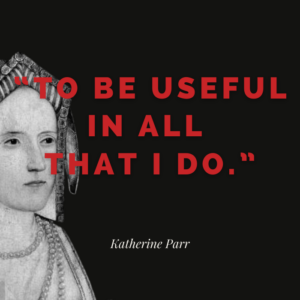 This could have been the end of Katherine’s story.
This could have been the end of Katherine’s story.
Katherine found herself a second husband: Lord Latimer John Neville, twice a widower and twenty years her senior. She had hoped that his country estate, Snape Castle, would be a place to live out the rest of her days in relative peace and prosperity.
She had survived a pandemic and maneuvered out of widowhood. But outside of her country retreat? England’s civil drama was just getting started.
Let’s step back and take a look at Katherine’s world:
In the fall of 1536, tensions were high. Queen Anne Boleyn–known to Catholics as the “concubine” who had seduced Henry VIII away from his wife and his church– found herself without a head.
Many power players assumed King Henry VIII would put aside this new “Church of England” and return to the proper faith. But the king enjoyed his new position as head of both England’s political and religious realm.
Instead, he doubled down, dissolving the monasteries and lining his treasury with their gold. Even worse, he relied on the “commoner” former Queen Anne Boleyn promoted to power, Thomas Cromwell, as his chief advisor.
The Nobility in Uproar
Back at Snape Castle, Katherine quietly immersed herself in books enjoying herself as Lord Latimer’s wife. She was aware of the tension around her. But what did it have to do with her?
As economic, political, and religious anxieties rose in England’s northern counties, Katherine’s world was rocked by rebellion: the Pilgrimage of Grace.
Although he was not a leader, her husband Lord Latimer joined his colleagues in protesting Henry’s actions.
One day, while her husband was away in London, Katherine awoke to find Snape Castle overrun with rebel leaders. Latimer’s own compatriots worried he was seeking to betray them to the king- so they took his estate…and his wife…hostage.
Katherine did not flinch. She never did.
Following in her mother’s legacy, she leaned on her independence and intellect to survive- both the rebellion and another tragedy: her second husband’s death.
In 1543, a widow a second time, Katherine steeled herself and moved forward yet again.
Katherine Parr’s Return To Court
Death was common in the 1500s.
Still, one has to wonder how Katherine’s repeated losses shaped her. Never able to “settle”, never finding a safe place for yourself can cause intense emotional trauma.
We don’t know much about her internal thoughts and grief at being left a widow once again, but we do know this:
On the outside, Katherine didn’t have time to cry.
She turned to her sister as a means to return to court. Anne Parr had served two of Henry VIII’s queens: Anne of Cleves and Kathryn Howard. Through her sister’s connections, Katherine secured herself a position in Princess Mary’s household and moved permanently to court at the age of thirty.
For Katherine, this was a rebirth given as a double-edged sword. She had an opportunity to flourish as a woman with means…but it was in the dangerous court of a volatile monarch.
Court life offered infinite possibilities compared to her former life on Latimer’s country estate. Katherine had a secured position in a royal household. She was old enough to have found her confidence- and young enough to enjoy courtly flirtation. Now, she could finally discuss Humanist scholarship with England’s most intelligent (and shrewdest) power players.
In short: Katherine’s tragedies had brought her to a third new life.
Katherine soon caught the eye of Thomas Seymour, a dashing courtier and the Prince of Wales’ uncle to boot. It was a fairytale romance that blossomed against a backdrop of wealth, intellectual progress, fashion, and entertainment. Katherine’s vivacity sparkled like a jewel in the crown of England itself.
Thomas Seymour was not the only person who had noticed the lively widow. Fate, as it turns out, was not finished with Katherine Parr…
Katherine Parr: The Queen Of Progress
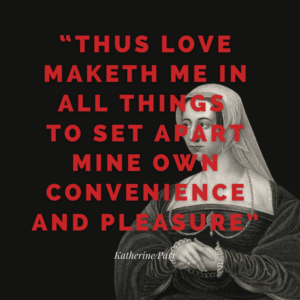 “Thus love maketh me in all things to set apart mine own convenience and pleasure”
“Thus love maketh me in all things to set apart mine own convenience and pleasure”
A marriage proposal from Henry VIII was not a request.
It was a royal command.
Katherine’s heart stopped. She finally had happiness within her grasp, but then the letter came.
Did she cry when she realized her fate in the summer of 1543? Maybe.
With characteristic practicality, Katherine was determined to make the best of the situation. She believed her now-inescapable ascension to the throne was God’s will. She vowed to use this new power for progress.
Katherine approached her marriage to England’s most infamous monarch, Henry VIII, with this modest motto: “To be useful in all that I do.”
As queen, she advocated for the cause of English vernacular and its use in religious reform. She supported reformers financially and loved to debate on the value of Protestantism. Katherine furthered the cause of female education, providing open forums for religious discussion among her ladies.
Katherine’s intellectual capability impressed her new husband. A year after their marriage, Henry set off on a military expedition to France and left Katherine Parr as Regent in his stead. A position no woman had held since her namesake, former queen Catherine of Aragon.
England’s First Published Female Author
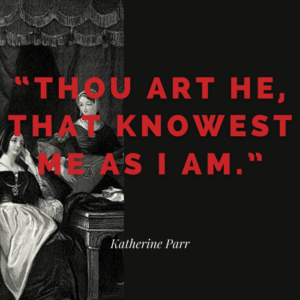 “Thou art he, that knowest me as I am.”
“Thou art he, that knowest me as I am.”
If Queen of England, acting regent, and powerhouse of female education wasn’t accomplishment enough for one lifetime…Katherine was just getting started.
Although she was not England’s first female author (Julian of Norwich holds that title for her 1393 Revelations of Divine Love), Katherine Parr is the first woman to be published under her own name in English.
Her Prayers and Meditations were published in 1544. Katherine’s oeuvre also includes The Lamentations of a Sinner and Psalms or Prayers. Her literary preoccupations were deeply connected to her faith. Unschooled in Latin or Greek, she firmly believed in the English vernacular, believing it key to spiritual betterment.
It’s clear why Katherine was such a strong advocate for Protestantism.
Unlike Catholicism, Protestantism offered more avenues for female engagement. Since mothers are responsible for their children, they had to be educated in order to teach them religious values. These values aligned with Katherine’s own upbringing, tying directly to her own mother’s sacrifices and priorities.
Katherine Parr’s works shine most as personal reflections. Katherine’s resilient individualism made this new church a natural fit.
While individualism and religious freedom today feels natural, you can’t overestimate how profound this shift from having a designated intermediary (i.e. a priest) to being “able” to talk to one’s God on your own behalf…and in your own language. Protestantism stressed individual salvation and interacting with religious texts in the more accessible vernacular.
Katherine Parr’s Religious Writing
Katherine’s religious writings showcase her voice in stunning clarity. To the modern reader, the text’s self-flaggation (a very popular technique at the time) is a little off-putting. But, it does reveal a slice of Katherine’s inner world that is uncommon for women of her class.
As scholar Janel Mueller observes, Parr is careful with using gendered language, preferring to write in first person, which has the radically inclusive effect of drawing women into the discussion: “Degendering from masculinist norms… ultimately results not just in universalizing but in articulations that are identifiably femine– those of the author.”
In an era where women were expected to fade into the background, Katherine’s bold proclamations, published for the world to see, are an act of bravery. Mueller refers to her writings as “her spiritual and human autobiography.”
But matters of God and matters of State were becoming rocky bedfellows. Katherine’s willingness to speak her mind and interest in religion soon were quickly becoming a liability to her life.
A Careful Courtly Dance of Survival
Henry VIII had nominally broken with Catholicism to create the Church of England. But the state-sponsored religion was Protestant only in name. Henry still subscribed to most Catholic theology. He simply favored claiming the Pope’s power and the monasteries’ wealth for himself.
It’s a story we still see today: Despots love embracing a trend or a change…as long as they’re the beneficiary.
Katherine’s consistent advocacy for reform was becoming a direct rebuke of the Church of England and therefore its supreme leader: King Henry VIII.
Bishop Gardiner, a mainstay of the old guard, took advantage of Katherine’s boldness. He stoked Henry’s growing annoyance of her religious exploration.
In 1546 Anne Askew, a Protestant preacher and poet, was executed for heresy. Anne shared many of Katherine’s viewpoints and may have attended religious discussions hosted by the queen. Although Gardiner was unable to get Askew to directly implicate Katherine, the execution was enough to challenge the appropriateness of Katherine’s religious ideals.
Gardiner drew up articles against Katherine and members of her household.
Somehow, Katherine uncovered the plot.
In the famous confrontation mentioned above, she saved her own head with cunning self-modesty.
Less than a year later, Henry VIII died.
Love On Her Own Terms
 “Methinks love maketh men like angels”
“Methinks love maketh men like angels”
Katherine was now a widow for the third time.
But this time? It must have felt freeing. As Dowager Queen, dozens of new doors opened, and she made her bid to “have it all.”
When Katherine married Henry VIII, she had also assumed an important role: stepmother to his three children:
Mary was only four years younger than Katherine. Filled with plenty of memories of her mother and the indignity of being named a bastard, Katherine bridged their relationship and became a loving friend.
For Katherine’s young stepchildren the situation was very different. Elizabeth’s mother, Anne Boleyn, had adored her daughter. But Elizabeth was only three at the time of her mother’s execution. Edward’s mother, Jane Seymour, had died in childbirth.
For Elizabeth and Edward, Catherine was truly the only mother they knew.
Katherine considered leveraging her political and personal influence to become Regent again, this time for the nine-year-old Edward VI.
It seems she may have been held back by a force more powerful than political gain…love.
Thomas Seymour returned to her life once more.
Katherine and Elizabeth
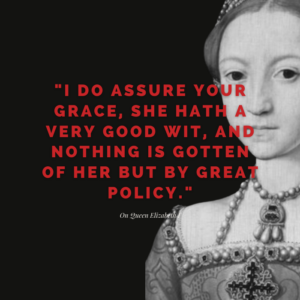 Despite the disappointment of losing the regency, she was finally free to live her own life. She married Thomas Seymour and published her second book. The couple also took on two new wards: the Princess Elizabeth and the heiress Lady Jane Grey (the ill-fated Nine Day Queen).
Despite the disappointment of losing the regency, she was finally free to live her own life. She married Thomas Seymour and published her second book. The couple also took on two new wards: the Princess Elizabeth and the heiress Lady Jane Grey (the ill-fated Nine Day Queen).
Katherine’s literary interests and intellectual curiosity were critical to Elizabeth I’s education. The two formed a strong bond. Elizabeth once presented Katherine with her own translation of The Mirror of the Sinful Soul by Marguerite de Navarre, another famous literary royal woman.
Unlike Katherine, Elizabeth was skilled in the scholarly languages of Latin and Greek. But “mother” Katherine steered Elizabeth’s education to include more contemporary ones, including French and Italian. Katherine’s influence on the young princess took her learning from the classical education popular at the time to more practical, modern skills that would become the backbone of Elizabeth’s transformational reign.
This period of Katherine and Elizabeth’s lives is marred by Thomas Seymour. Katherine became pregnant shortly after her marriage. In this time, there are strong rumors around Thomas’ interaction with the teenage Elizabeth in ways we now recognize as sexual abuse.
Nevertheless, even in this less-than-perfect environment, Katherine’s influence on Elizabeth is one of her most enduring legacies. Katherine did not live to see Elizabeth ascend the throne, but the honors Elizabeth bestowed on Katherine’s family and friends show a continued gratitude to and fondness for her stepmother.
As Katherine Parr’s biographer, Linda Porter, observed: “The adult Elizabeth was very much the product of Katherine Parr. Her education, her religious beliefs, her consciousness of personal image owed much to the stepmother who guided and loved her during those formative years. Katherine had brought up a talented and determined girl, open-minded by the standards of her day, who was not afraid to rule.”
Katherine Parr: A Legacy Ended Too Soon
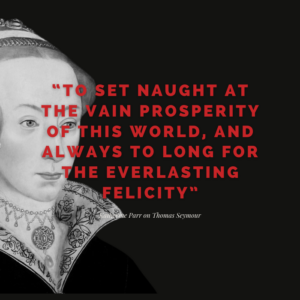 “To set naught at the vain prosperity of this world, and always to long for the everlasting felicity”
“To set naught at the vain prosperity of this world, and always to long for the everlasting felicity”
When Katherine Parr went into labor in August 1548, she was 36 years old.
Childbirth was a perilous affair for every Renaissance woman, but Katherine met it with her signature determination and faith.
However, Katherine’s personal strength could not compensate for the barbarous medical practices of the time. She contracted “childbed fever,” a catchall term for infection resulting from poor hygiene in the birthing room, and died on September 5, 1548.
Katherine Parr’s funeral has the distinction of being England’s first Protestant funeral to be conducted in English instead of Latin, a touch she would have loved. However, the daughter who she sacrificed herself for, Mary, disappears from the historical record in 1550. We can only assume she passed away in childhood.
Katherine’s death seems unfair.
She was still young and just starting a burgeoning literary career. With her protogée’s eventual ascension to the throne, Katherine likely would have wielded significant power and influence in Elizabeth I’s court. We can only imagine what a court ruled by two strong women would have contributed toward England’s legacy.
But Katherine would reemerge from death one last time.
A Royal Tomb Lost and Discovered
Centuries after her death, Katherine’s tomb was lost within the ruins of the now-abandoned Sudeley Castle. When an 18th century touring party decided to explore the ruins, they were not expecting to stumble upon a royal tomb. Curious, they pierced the lead envelope and pulled back her shroud.
Katherine Parr Borough Neville Tudor Seymour, Queen of England, looked back at them across the sands of time, perfectly preserved if she were just about to emerge from sleep.
In a biological phenomenon, the undisturbed lead had protected Katherine Parr’s body from decomposition. After the shock and awe of seeing her uncorrupted body, the tourists reburied her.
The broken lead envelope could no longer protect her and decay set in.
As she had in life, Katherine Parr proved an extraordinary woman who defied the odds even in death. Her ability to overcome adversity and leverage her skills to make the most out of every situation is strikingly modern and an inspiration to any woman seeking to flourish in a troubled world.

